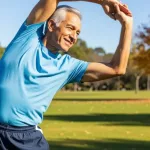
How mobility exercises are important for seniors?
Gaining mobility through targeted exercises can transform seniors' lives by enhancing independence and reducing injury risk, but how exactly does it work?


When was yoga developed? Its origins stretch back over 5,000 years in ancient India, where early practices focused on uniting mind and body. Over time, these traditions evolved through meditation, breath control, and mindful movement, laying the groundwork for techniques we still use today. But how did these ancient practices transform into the structured routines and texts, like the Yoga Sutras, that guide modern fitness and wellness? Exploring this history reveals a living tradition that continues to shape holistic health.

Although the exact origins of yoga are difficult to pinpoint, it is widely accepted that yoga developed in ancient India over 5,000 years ago.
Early practices focused on harmonizing mind and body through safe, controlled techniques. These foundational elements emphasized well-being and balance, ensuring practitioners could engage in yoga with attention to physical and mental safety.
You might like to read: Benefits of Yoga
During the Vedic period, which dates from approximately 1500 to 500 BCE, early yoga concepts began to take shape within the spiritual and philosophical texts known as the Vedas.
These teachings emphasized meditation, breath control, and ethical living as paths to spiritual growth.
The focus was on safe, gradual self-discipline, promoting harmony between mind, body, and environment.
The Upanishads, composed between 800 and 200 BCE, expanded upon early Vedic teachings by introducing more detailed philosophical discussions on the nature of the self and ultimate reality.
They emphasized meditation, ethical living, and self-discipline as essential elements of yoga.
These texts laid a safe foundation for understanding inner peace and spiritual growth without physical risk or harm.
Building on the philosophical foundations established in the Upanishads, the Bhagavad Gita further articulates yogic principles within the context of a moral and spiritual crisis.
It presents yoga as a path to self-realization, emphasizing duty, devotion, and disciplined action.
The text offers guidance for maintaining inner peace and balance, promoting a safe and steady approach to spiritual growth.
Although rooted in earlier traditions, the Classical Period marks a distinct consolidation of yogic thought through Patanjali’s Yoga Sutras.
This foundational text systematically outlines the eightfold path, emphasizing ethical conduct, meditation, and mental discipline.
It provides a clear framework for safely practicing yoga, focusing on inner peace and self-awareness, ensuring practitioners can engage with confidence and mindfulness.
Patanjali’s Yoga Sutras laid a theoretical foundation that influenced subsequent yogic practices.
During the medieval period, Hatha Yoga emerged, emphasizing physical postures, breath control, and purification techniques. These developments aimed to prepare the body safely for meditation and spiritual growth.
Texts like the Hatha Yoga Pradipika codified these practices, prioritizing balance and well-being for practitioners.
As interest in Eastern philosophies grew during the late 19th and early 20th centuries, yoga began to attract attention beyond India’s borders.
Influential teachers introduced safe, structured practices to Western audiences, emphasizing physical postures and meditation.
This careful transmission guaranteed yoga’s foundational principles were respected, allowing practitioners to explore its benefits within secure and supportive environments, fostering gradual acceptance across diverse cultures.
Since the mid-20th century, yoga has evolved into a global phenomenon, characterized by diverse styles and widespread practice.
The modern yoga movement emphasizes accessibility, physical health, and mental well-being while maintaining respect for traditional roots.
Certified instructors and standardized practices promote safe engagement, ensuring practitioners can benefit from yoga’s holistic approach without undue risk or harm.
While rooted in ancient traditions, contemporary yoga has adapted to meet the needs of a modern and diverse audience.
Emphasizing safety, many practices now incorporate modifications and accessible techniques to prevent injury. Classes often focus on mindfulness, gentle stretching, and breath control, ensuring participants of all levels can engage confidently.
This evolution reflects growing awareness of physical limitations and personal well-being.
Yoga, developed over 5,000 years ago in ancient India, has evolved through significant historical and philosophical stages. From its early roots in the Vedic and Upanishadic periods to the foundational teachings of the Bhagavad Gita and Patanjali’s Yoga Sutras, yoga has continually adapted. Its transmission to the West and subsequent modern movements have expanded its reach, making yoga a diverse and globally practiced discipline focused on harmonizing mind and body for overall well-being.

Gaining mobility through targeted exercises can transform seniors' lives by enhancing independence and reducing injury risk, but how exactly does it work?

Jumpstart your strength training by syncing workouts with your menstrual cycle—discover the surprising benefits that await when you train with your body’s rhythm.

Get the best techniques to stretch your knee effectively and safely, improving flexibility and preventing injury—discover the key moves you shouldn’t miss.

Learn how stretching before exercise boosts performance and prevents injuries, unlocking benefits you might be missing out on. Discover the key reasons now.

The ultimate guide reveals essential techniques and tips to prevent injuries—discover how simple changes can protect your body and enhance your performance today.

Wondering if stretching after working out is truly mandatory? Discover the surprising benefits and expert insights that might change your routine forever.